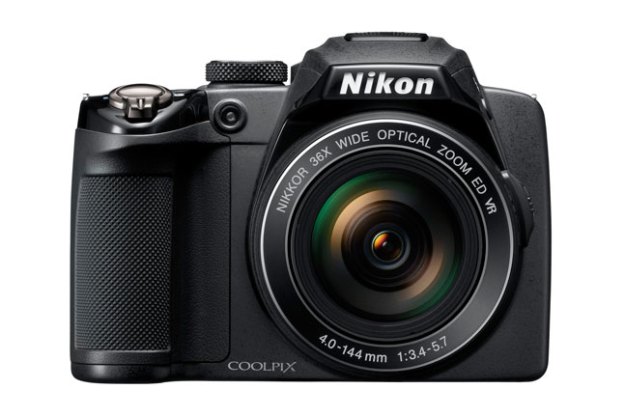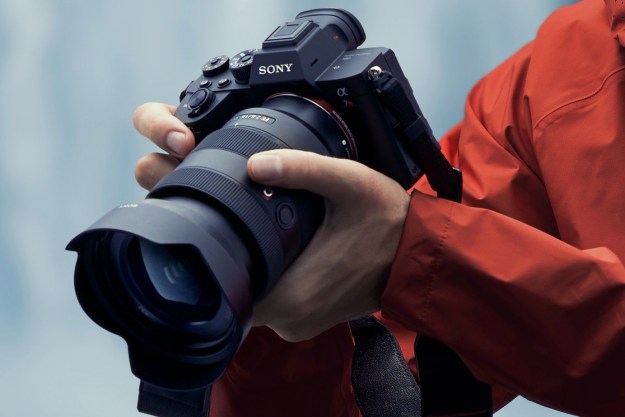
“The P500 has its flaws -- as does every camera – including battery life and image stabilization. The pluses far outweigh the negatives.”
- 36x optical zoom (22.5-810mm)
- 12-megapixel BSI CMOS sensor
- 8fps for five shots
- 1080p video capture
- Sensor-shift stabilization not as good as OIS
- Battery only rated for 220 shots
- Awkward placement for burst key
- Uses AC adaptor charging
The new Nikon Coolpix P500 has an incredible 36x optical zoom packed into a DSLR-like body. Get ready to hold your breath and capture subjects you didn’t even know were there!
Features and Design
We’ve always had a soft spot for megazoom cameras. They offer amazing focal ranges and are perfect for anyone who wants the long telephoto reach of a DSLR without spending a fortune on interchangeable lenses or dealing with the bulk. When we used a 14-megapixel Canon PowerShot SX30 IS with a 35x zoom, it literally rocked our world — photographically speaking, of course. The 24-840mm range was startling as we could zoom in on things that were totally unrecognizable with normal eyesight. Now Nikon has expanded this range to 36x by going a bit wider to 22.5mm with a telephoto that’s “only” 810mm. Yeah, it’s ridiculous, but lots of fun as we’ll soon see.
The Coolpix P500 has a definite DSLR vibe, but since there’s no mirror-box assembly, larger APS-C sensor or lens mount, the camera is noticeably less bulky and lighter (we placed a Canon T3 with lens attached next to it for comparison). Available in black or burgundy, the P500 measures 4.6 x 3.3 x 4.1 (W x H x D, in inches) and weighs 17.5 ounces fully loaded with battery and card. The T3 weighs that much for the body alone.

The mode dial lets you pick your level of camera interactivity. Along with auto, there’s program, shutter- and aperture-priority, and manual. Scene gives you access to 16 options including Scene Auto Selector, which is like Smart Auto or Intelligent Auto from other manufacturers. Here the camera guesses the subject in front of it and adjusts accordingly. This system works well. There are seven choices and three are repeated on the dial (night landscape, night portrait, backlighting). On the dial you’ll also find smart portrait and user, for you own preferred settings. Thanks to the speedy CMOS sensor, the P500 takes multiple frames in several of these modes for better overall exposures. One of our favorites is HDR, which is an option under backlighting. Here the camera takes several shots and merges them. The results are quite good, as it really brings out shadow details. Although buried somewhat, this is an excellent feature found on many 2011 Coolpix models.
Almost all megazooms have LCD screens and electronic viewfinders (EVF) — the P500 doesn’t disappoint. On the back you’ll find a .24-inch EVF rated 230K pixels with diopter control. It also has a vari-angle 3-inch monitor rated a fine 921K pixels. The screen doesn’t swing out from the body like the Canon SX30 IS — it pulls out and you can tilt it up and down for shooting overhead, or at waist level. It’s a very useful feature, but we wouldn’t suggest snapping a super telephoto with one hand. The P500 may have five-way vibration reduction, but no way can it can hold steady in that situation. As with any extreme telephoto shot, definitely brace the camera while shooting.
Also on the back is a monitor button so you can switch between the LCD and the EVF, Display for changing the icons on screen and a red dot video button for instantly grabbing full HD movies. A nice feature is a surrounding toggle that lets you shoot HD or HS (high speed) clips. Instead of 30fps it does 240fps QVGA so you can check out slow-mo clips without sound.

On the right is a connection for an optional AC adaptor, while on the left is a compartment for USB and mini HDMI connections. This door hinge is rather flimsy, so be careful you don’t yank it off. You’ll also find a speaker, a flash up button and another zoom toggle on the lens so you can use your left thumb to make adjustments while using a two-handed grip.
The bottom of the made-in-Indonesia digicam has a metal tripod mount and a compartment for the battery and SD card (it accepts SDXC media).
What’s in the box
If you decide to buy this megazoom, you’ll get the camera, strap, lens cap, USB and A/V cables. You charge the battery in-camera using the supplied AC adaptor and USB cable. We prefer separate chargers so your camera isn’t out of commission while juicing up. A spare would be in order if you plan to be outdoors all day, since the battery lasts for 220 shots, per CIPA. We were OK during our review sessions, but definitely see the need for an extra if no outlets are nearby — especially if you’re on a vacation. You also get a multi-language Quick Start Guide (28 pages in English) while the full manual and ViewNX2 software are on individual CD-ROMs.
Performance and use
The Nikon Coolpix P500 features a backside illuminated (BSI) 12-megapixel CMOS sensor. The same chip is found in many 2011 digicams. We’ve been pretty happy with the results as image quality is good, digital noise is under control and overall response is quite speedy. Realize this is a much smaller chip than those found in DSLRs, so image quality and noise handling cannot be similar. But cameras are a lot more than chips so let’s dig in…
We had the camera with us for several weeks, taking it to the seaside and city-side. The P500 is definitely not a pocket-sized Canon ELPH or Sony T series, so forget about sticking it in your jeans; shorts with cargo pockets are more like but even that’s a drag. Attach the strap, put it on your shoulder and off you go.
The P500 has good ergonomics, other than the placement of the burst button. Even though there are two zoom toggles, we forgot about the one on the lens barrel most times. Nikon’s menu system has gray whiskers in this iPad age, but it’s more than serviceable. As usual we started off in auto, moved to Scene Auto Selector then onto more manual tweaks. All shots were taken at maximum resolution (4000 x 3000); videos were full HD 1080p. Unlike some other Mega-Zooms, the P500 only captures JPEGs, not RAW files. If this is important to you, check out the Panasonic FZ100, but it only has a 24x zoom. Once done, images were reviewed on the monitor, prints made and movies watched on a 50-inch plasma via HDMI as well as the PC.

We have to admit the wide-angle 22.5mm setting had more initial appeal than the 810mm telephoto. This setting adds a dramatic perspective distortion—especially for building-scapes, landscapes and scapes of all types. We shot many images along the boardwalk of the Jersey Shore and loved the perspective at extreme wide-angle. From that point, we zoomed to the far end of boardwalk, capturing a sign we couldn’t even see. Not to beat this to death, you’ll find this the case as you zoom in to 810mm. Unlike the Canon SX30 IS, the P500 zoom moves fluidly through the entire range; the Canon “hitched” a bit. On the plus side for the SX30 IS is its optical image stabilization. Handheld photos were rock solid with minimal blur — we couldn’t say the same thing at all times for the Nikon’s image sensor shift system, which also boosts ISO. Subjects in bright sunshine were crisp; in shadows not so much. Overall we much prefer OIS. That on the table, you really have to be careful using these cameras — or any camera — at maximum telephoto. A monopod would be best, but definitely wedge your elbows into your body and hold your breath when snapping the shutter.
The Canon also has another plus: a Zoom Framing Assist button. When you’re shooting at 800mm or so, if the subject moves slightly, it can easily be lost in the viewfinder or LCD. With Canon’s assist button, the zoom pulls back so you can find your target; tap it again and it zooms back, hopefully framing the object of your desire. This is not a deal breaker by any stretch — just something you should be aware of. Also note the Canon uses a 14-megapixel CCD with a whopping 1.3fps burst mode, compared to 8fps for 5 shots by the 12-megapixel Nikon. The P500 also takes 1080p videos at 30fps versus 720p at 30fps for the Canon. Clearly the newer CMOS sensor is the key difference. Needless to say, we’d love to see an updated 30SX with this type of chip, but back to the Coolpix…

As stated earlier, we had the P500 around and about. Walking through Manhattan streets offers subjects galore. We really, really liked the 22.5mm setting, especially with NYC architecture. It provides just enough distortion to make almost anything interesting but don’t do portrait close-ups or you’ll lose friends for life! We tended to go zoom crazy, as we expect you will. However, going to the other end of the spectrum, macro shots were outstanding. After hundreds of shots, we were quite happy with the colors and results of this camera.
The Coolpix P500 has ISO capabilities to 3200. In our tests, there was little digital noise until ISO 1600. At that point, color accuracy fell to the floor and noise reared its ugly head. Still for a point-and-shoot with a small sensor, images were quite good. Try to keep your setting at 800 or below for best results. And don’t forget to make the most of the BSI chip — night landscape and backlighting settings as well as HDR — will definitely impress. The camera definitely slows down as it stitches frames together, but you’ll be pleased with the results.
Overall, movie clips were good, but the camera had difficulty focusing faraway subjects at the maximum zoom level. We shot a speed boat offshore, but the P500 couldn’t lock in — as we pulled back, the videos were much improved with good color and few compression artifacts. The camera only uses electronic image stabilization in video mode to eliminate potential mechanism noise. We’d live with it, if we had our druthers.
Conclusion
We have no problems recommending the Nikon Coolpix P500. It’s a great camera for those heading for vacations, as you’ll have a huge focal range at your fingertips. Photo quality is solid, and you have loads of tricks to play with beyond the basic digicam, thanks to the new CMOS sensor. The P500 has its flaws — as does every camera – including battery life and image stabilization. The pluses far outweigh the negatives. Zoom on!
Highs:
- 36x optical zoom (22.5-810mm)
- 12-megapixel BSI CMOS sensor
- 8fps for five shots
- 1080p video capture
Lows:
- Sensor-shift stabilization not as good as OIS
- Battery only rated for 220 shots
- Awkward placement for burst key
- Uses AC adaptor charging
Editors' Recommendations
- The best photography tripods
- The best digital cameras
- Nikon Coolpix P950 vs. P1000: Superzoom showdown
- Nikon D750 vs. D780: 5 years in the making, Nikon’s newest proves its worth
- Nikon meshes 2,000mm zoom capabilities with 4K video in the superzoom P950



